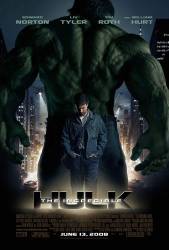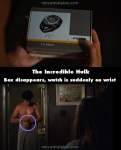Question: In the alternate opening of this movie, there have been many rumors of Captain America's cameo frozen in the ice as the Hulk smashes it and a big wave of ice shatters. If you look at it very carefully it does seem that it is him. So does anyone know if there has been any confirmation that it is him?
Answer: Yes. In the alternate opening, after Bruce turns into the Hulk and causes the ice to collapse, a huge chunk of ice is broken free from the ground. In this ice is a figure dressed in blue holding a round shield with circular red and white stripes. The best way to see this is waiting until the huge ice wall breaks and then slowly advance frame-by-frame and eventually Captain America and his shield will be seen.
Chosen answer: No, none whatsoever. It's something thrown in by the effects department and that fact that it only exists in a deleted scene makes it a mere curiosity and not any sort of canonical representation of the movie version of the character. With a dedicated Captain America film in production, intended to be released in 2011, they would not have thrown in anything definitive regarding the character into an earlier film, to avoid placing constraints on those making the character's own film. While, yes, Steve Rogers will almost certainly end up frozen in ice at some point, that will be dealt with by his film without worrying about an Easter Egg thrown into a previous movie.
Question: Why are the flags on the soldiers' uniforms backwards? They're American flags, but the stars are on the right hand side of the flags. Was the scene just flipped post-shooting or is there some other reason?
Answer: According to the Department of Defense website, the flag, when worn as a patch, should be placed on the sleeve so that the flag gives the impression as if it is flying in the breeze, as the person wearing the patch moves forward. That means the blue/white field of stars should be in the forward position with the stripes trailing. That is why there are "left" patches and "right" patches made for the left and right sleeves. It is only the "right" sleeve patches that appear backwards when seen on the uniform's right sleeve.
Question: Is it necessary to view Hulk before seeing this film? Or is it stand-alone with a self-contained storyline?
Chosen answer: It's entirely self-containing - effectively the film acts as a relaunch of the franchise rather than a continuation, although it doesn't really have any continuity issues with the first.
Question: Although some of Bruce Banner's blood falls into one of the soda bottles when he's working in the factory, the movie never explains what happens to that specific bottle. Can we assume that it gets exported to the United States and someone eventually drinks it? Will this tie into the plot for the sequel?
Answer: This is explained in the movie, and it's where Stan Lee's cameo comes in. He is the person who drinks the contaminated soda, triggering a "gamma sickness" incident.
Question: During the botched raid on the university campus, the troops move in too quickly (alerting Bruce Banner), and General Ross snarls, "I wanna know who jumped the gun!" Did General Ross ever find out who jumped the gun? Was it Emil Blonsky? If it was Blonsky, why did General Ross never reprimand him?
Answer: Since some time has passed probably between the Hulk taking Betty to safety and General Ross talking to Doc Sampson, there's a possibility that he was told who was responsible for alerting Bruce to their presence. When Bruce looks up, it isn't Blonsky he saw but another soldier.
Question: What happened to the old man when he drank the soda that had the Hulk's blood in it?
Answer: Banner's blood has gamma radiation poisoning. To anybody but Banner, the amount is lethal, but due to his biology it does not kill him. But there is enough there that even that small bit of blood that wound up in Stan Lee's bottle was enough to make him very sick with gamma radiation poisoning, so he was taken to the hospital for treatment. His condition was reported at the hospital, which is why General Ross and his crew were alerted to it and were able to find Banner. But Stan Lee was taken to the hospital. What happened to him after that is not revealed in the movie.
Question: What did General Ross mean when he told Betty that she couldn't see things?
Answer: Maybe that she is blind from her love for Bruce and she couldn't see that Hulk is a monster that can devastate a whole city in minutes.
The way I've always seen it, General Ross is the one who can't see things, considering he wants to use the Hulk as a weapon.
Question: In the trivia section, it's stated that the name Bruce Banner was changed to David Banner in order to avoid misleading audiences on the sexual orientation of the character. In which way is the name Bruce related to being gay? May be to obvious, but I'm not familiar with American pop culture.
Chosen answer: There are many jokes, especially in the late 70's, equating Bruce with "gay." There's nothing that makes the name gay. But like "Lance" or "Percy," it's a stereotype perpetuated by popular culture.
Question: Before the first attack on Bruce, General Ross tells the men that he is suspected in the death of two Canadian hunters. Is this by any chance a reference to the Hulk Vs. Wolverine story that came out as an animated film the same year as this film?
Chosen answer: Possibly. More in line as a reference to the comic story rather the animated feature.
Question: If Tim Roth is on loan from the SAS and is British, why does he wear US uniforms including the US flag (visible on the helicopter before they land in New York for the final battle)?
Answer: Likely it is because he is meant to blend in with his US counterparts. Wearing a British uniform might be misconstrued as representing the British armed forces, which he is not. It may not be exactly with the rules of the military, but the army might not have wanted to attract notice that they had to get outside help.
Question: Anybody think that Tim Roth's character aping his way up the inside of the stairwell may have been inspired from his appearance as a chimpanzee in the Tim Roth version of "Planet of the Apes?"
Answer: Very likely, as Roth trained with the same trainer as he did for Planet of the Apes.
Question: Why is it that in the part of the movie, when Banner has a beard, the beard does not show up when he transforms into the Hulk?
Answer: The Hulk is not human; The Hulk being may not even be able to grow facial hair, which certainly would be a perfectly normal explanation for why he never has a beard. Native American members of my family can't grow a single hair on their chins, but their direct half-siblings have full, flowing beards; perhaps something similar is happening here.
Question: I know that Sam Elliott, who played General Ross in 2003 Hulk, wanted to play him again in this movie. Why was he rejected and replaced with William Hurt?
Answer: Presumably because this movie was retooled into a reboot that wasn't meant to connect with the 2003 film. So bringing back main cast members might have been seen as being potentially too confusing at the time. (This was nearly 10 years prior to JK Simmons being cast again as J. Jonah Jameson, which proved audiences can go with the same actors being in reboots. But in 2008, it probably would have been viewed as being too risky).
I do think you're right, although it's worth pointing out that Judi Dench was recast as M in the rebooted 2006 Casino Royale after playing her in the Brosnan Bond films. Not sure if that was the first time that's happened.
That is true, although I'd consider it a slightly different circumstance because the Bond films are basically a singular linear film series following one main character, and it was made clear that "Casino Royale" was essentially a full-on reboot. Comparatively, the MCU is multiple different stand-alone "series" (Iron Man, Hulk, Thor, etc.) that all tie together via crossovers, cameos and team-up films. They were probably worried that people would assume the 2003 movie was retroactively part of the MCU. (Which you could probably argue is now true given the establishment of the multiverse, and the implication that previous non-MCU Marvel movies are all canonical as part of the multiverse... but that wasn't part of the plan at the time this movie was made).







Chosen answer: Neither. Martina was simply a woman who happened to live in the same building and work in the same factory as Bruce. She was however attracted to him.